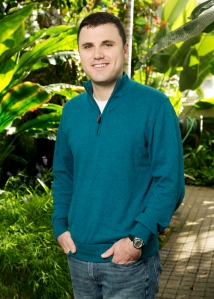
Huertas Intensivas – Research plots at the UST Stewardship Garden
One of the best things about doing research at St. Thomas is the relationships that develop between students and professors. Learning about the subject of our research from an expert in the field is invaluable; their experience and knowledge helps more than hours of individual research. The other good aspect of learning this way is being able to have a relationship with your professor and other community leaders outside of an impersonal lecture setting.
Recently, some members of our UST Stewardship Science team were able to have a discussion about the science of urban agriculture with Sam Wortman, a professor in Crop Sciences and Urban Food Production at the University of Illinois. Dr. Wortman graduated with St. Thomas in 2007 with a degree in Biology. Dr. Wortman obtained a position at Illinois after completing a M.S. in Crop Production in 2009 and a Ph.D. in Applied Ecology in 2012 from the University of Nebraska. The Stewardship Science team read a paper on urban farming by Dr. Wortman and his colleague Sarah Lovell published in the Journal of Environmental Quality in 2013. Adam contacted Dr. Wortman to see if he would be willing to talk to the team about it over Skype.

The paper was a literature review of the current science surrounding urban farming; Dr. Wortman used the process of writing the paper as a starting point for organizing his current research interests.
The focus of our conversation was largely on water used for irrigation in urban farming. Two members of the stewardship science team, Acadia Stephan and Liam Coulter, are interested in designing and building a rainwater collection system to be used on a plot of land on the St. Thomas campus.
There were a number of questions Dr. Wortman was able to answer and help us with about water and specifically rainwater collection.
First, we asked about contaminants that could be present in rainwater collected from a rooftop. Birds, squirrels and other animals can contribute to bacteria and harmful microbes that can be present in water collected from a rooftop, and the roof itself can leach harmful chemicals into the water. We learned from Dr. Wortman that these contaminants are only present in appreciable amounts in the “first flush” of water coming off the roof, meaning the majority of the water would be clean and usable for irrigation. However, even contaminants from a first flush may have limited impact on food production if a drip irrigation system is used, because contaminant transfer generally occurs from water application to leaves and fruits.
Another subject that Dr. Wortman talked about was the sustainability of water use in urban agriculture. Right now, the only water being used for irrigation of urban gardens and lawns is potable water. While currently inexpensive and available for many (though not all) urban residents, it is not sustainable in the face of growing demand and potential future droughts. Using rainwater collected from rooftops could potentially be a good way to sustainably source irrigation water. Our group at the University of St. Thomas hopes to help develop efficient and safe means of harvesting and using rainwater to increase the resilience of the irrigation system in urban environments.
The conversation with Dr. Wortman was an example of a mentor-mentee situation where we on the stewardship science team can learn while developing a personal connection with professionals in the field. Dr. Wortman also provides an example of how a talented and dedicated individual could go from being an undergraduate student at St Thomas to a professor at a major research university in less than a decade.
